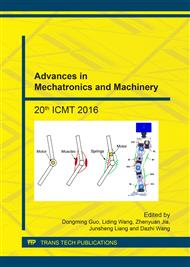[1]
Zi Qiang Zhang, Chuan Jiang Li, Li Li Wan, Optimization and realization of a rotor dynamic balance measuring algorithm, C. /2010 3rd International Congress on Image and Signal Processing(CISP2010). Yantai: IEEE Press, 2010. 4109-4112.
DOI: 10.1109/cisp.2010.5648066
Google Scholar
[2]
Hong Bing Ouyang, Sheng Zeng, Xi Xuan Wang, Summary and prospects for automated balancing on line of rotor system, J. Journal of Mechanical Strength. 19, 4 (1999) 20-24.
Google Scholar
[3]
Xin Pan, Hai Qi Wu, Jin Ji Gao, Review for liquid-typed online auto-balancing devices in rotor-bearing systems, J. Journal of Vibration and Shock. 34, 6 (2015) 95-100.
Google Scholar
[4]
Branislav Hredzak, Guo Xiao Guo, Investigation of the feasibility of active balancing of hard disk drives, J. Mechatronics. 1, 2 (2004) 853-859.
DOI: 10.1016/j.mechatronics.2004.02.001
Google Scholar
[5]
Zhen Wei Wang, Yan Fei Chen, Yu Bing Guo, etc, The research progress of automatic balancing technology, J. China Science and Technology Information. 73, 9 (2012) 124-125.
Google Scholar
[6]
Hong Yan Jiang, Zhong Hao Huang, Feng Cheng, Jun Yuan Wang, Study on on-line dynamic balance of high-speed spindle system and it's simulation, J. Manufacturing Technology and Machine Tool. 4 (2009) 47-51.
Google Scholar
[7]
Ke Jian Jiang, Chang Sheng Zhu, Auto balance of active magnetic bearings for rotor support system by means of unbalance identification, J. Journal of Vibration Engineering. 22, 6 (2009) 559-564.
Google Scholar
[8]
Xiao Wei Huang, Zhong Lin Tang, New method for autobalancing with active magnetic bearings, J. Chinese Journal of Mechanical Engineering. 37, 7 (2001) 96-99.
DOI: 10.3901/jme.2001.07.096
Google Scholar
[9]
Xiao Chun Xu, Introduction of vibration mode balancing for flexible rotor, J. Coastal Enterprises and Science & technology. 4 (2010) 38.
Google Scholar
[10]
Soo Hun Lee, Bong Suk Kim, Jong Duck Moon, Do Hyung Kim, A study on active balancing for rotating machinery using influence coefficient method, C. /Proceedings 2005 IEEE International Symposium on Computational Intelligence in Robotics and Automation. Espoo: IEEE Press, 2005. 659-664.
DOI: 10.1109/cira.2005.1554352
Google Scholar
[11]
Jong Soo Kim, Soo Hun Lee, The stability of active balancing control using influence coefficients for a variable rotor system, J. The International Journal of Advanced Manufacturing Technology. 22 (2003) 562-567.
DOI: 10.1007/s00170-003-1551-z
Google Scholar
[12]
Zhen Wei Wang, Yan Fei Chen, Yu Bing Guo, etc, The research progress of automatic balancing technology, J. China Science and Technology Information. 73, 9 (2012) 124-125.
Google Scholar
[13]
Qing He, Hong Li, Hui Xie, Virtual instrument of vibration measurement and dynamic balancing based on LabVIEW and NI9233, C. /2008 Chinese Control and Decision Conference. Yantai: IEEE Press, 2008. 1622-1625.
DOI: 10.1109/ccdc.2008.4597592
Google Scholar
[14]
Jong Duk Moon, Bong Suk Kim, Soo Hun Lee, Development of the active balancing device for high-speed spindle system using influence coefficients, J. International Journal of Machine Tools and Manufacture. 46, 9 (2006) 978-987.
DOI: 10.1016/j.ijmachtools.2005.07.048
Google Scholar
[15]
Jing Ping Chen, Pu Qiang Yan, Relative Influence coefficient method-effective in field balancing of flexible rotors, J. Journal of Vibration, Measurement and Diagnosis. 14, 4 (1994) 1-6.
Google Scholar
[16]
Wen Ping Lei, Jie Han, Hong Chen, Xiao Yun Gong, The modified balance method based on precession decomposition, C. /Computer Science and Automation Engineering(CSAE), 2011 IEEE International Conference on(Volume: 2). Shanghai: IEEE Press, 2011. 632-636.
DOI: 10.1109/csae.2011.5952549
Google Scholar
[17]
Shi Lei Ma, Shi Yuan Pei, Lin Wang, Hua Xu, Shen Yong Zhang, Dynamic balancing with online electromagnetic balancing device, J. Journal of Xi'An JiaoTong University. 46, 3 (2012) 21-26.
Google Scholar
[18]
Ronny Ramlau, Jenny Niebsch, Imbalance estimation without test masses for wind turbines, J. Transactions of the ASME: Journal of Solar Energy Engineering. 131 (2009) 11010, 1-7.
DOI: 10.1115/1.3028042
Google Scholar
[19]
Yong Fu Wang, Tian You Chai, Present status and future developments of adaptive fuzzy control, J. Control Engineering of China. 13, 3 (2006) 193-198.
Google Scholar
[20]
Min Hua Li, Shu Qin Liu, Fuzzy PID control of magnetic bearing, J. Control Engineering of China. 11, 5 (2004) 409-412.
Google Scholar


